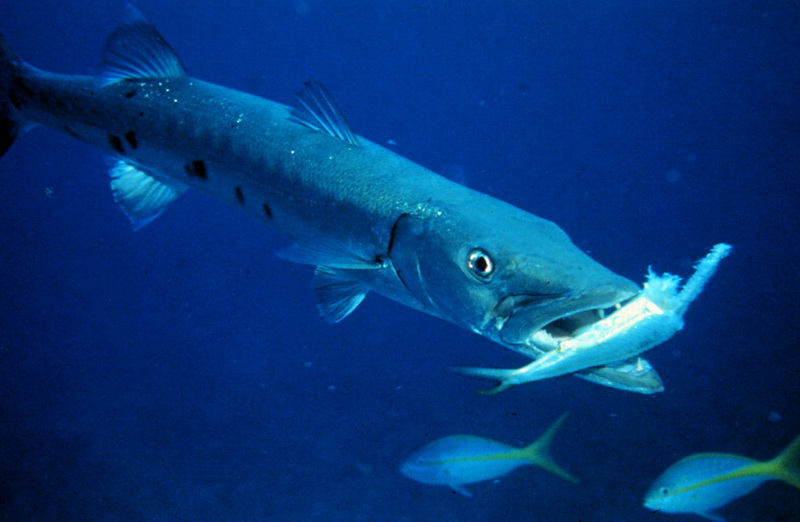|
| 질의: small white | 결과: 1625번째/2237 | |
Great Barracuda (Sphyraena barracuda) - Wiki
| 제목: | Great Barracuda (Sphyraena barracuda) - Wiki
| |

| 해상도: 800x522
파일크기: 108458 Bytes
촬영일: 2007:08:16 00:32:01
등록시간: 2007:08:16 00:34:49
|
Great barracuda
From Wikipedia, the free encyclopedia
[Photo] Great barracuda with prey. Image ID: reef2567, The Coral Kingdom Collection. Photographer: Florida Keys National Marine Sanctuary Staff. Credit: Florida Keys National Marine Sanctuary
The Great Barracuda is a species of barracuda. Its binomial name is Sphyraena barracuda. Great barracudas often grow over 6ft long. The great barracuda is a type of ray-finned fish.
Appearance
Barracudas are elongated fish with powerful jaws. The lower jaw of the large mouth juts out beyond the upper. Barracudas possess strong, fang-like teeth. These are unequal in size and set in sockets in the jaws on the roof of the mouth. The head is quite large and is pointed and pike-like in appearance. The gill-covers do not have spines and are covered with small scales. The two dorsal fins are widely separated, with the first having five spines and the second having one spine and nine soft rays. The second dorsal fin equals the anal fin in size and is situated more or less above it. The lateral line is prominent and extends straight from head to tail. The spinous dorsal fin is placed above the pelvics. The hind end of the caudal fin is forked or concave. It is set at the end of a stout peduncle. The pectoral fins are placed low down on the sides. The barracuda swim bladder is large.
In general, the barracuda's coloration is dark green or grey above chalky-white below. This varies somewhat. Sometimes there is a row of darker cross-bars or black spots on each side. The fins may be yellowish or dusky.
Behavior
Barracudas appear in open seas. They are voracious predators and hunt using a classic example of lie-in-wait or ambush. They rely on surprise and short bursts of speed (up to 27mph (43 km/h)) to overrun their prey, sacrificing maneuverability. Barracudas are more or less solitary in their habits. Young and half-grown fish frequently congregate in shoals. Their food is composed almost totally of fishes of all kinds. Large barracudas, when gorged, may attempt to herd a shoal of prey fish in shallow water, where they guard over them until they are ready for another meal.
http://en.wikipedia.org/wiki/Great_barracuda
| The text in this page is based on the copyrighted Wikipedia article shown in above URL. It is used under the GNU Free Documentation License. You may redistribute it, verbatim or modified, providing that you comply with the terms of the GFDL. |
|
^o^
동물그림창고 똑똑전화 누리집
^o^
|
|